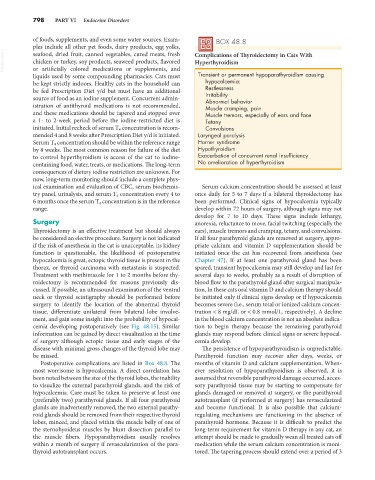Page 826 - Small Animal Internal Medicine, 6th Edition
P. 826
798 PART VI Endocrine Disorders
of foods, supplements, and even some water sources. Exam- BOX 48.8
ples include all other pet foods, dairy products, egg yolks,
VetBooks.ir seafood, dried fruit, canned vegetables, cured meats, fresh Complications of Thyroidectomy in Cats With
chicken or turkey, soy products, seaweed products, flavored
Hyperthyroidism
or artificially colored medications or supplements, and
liquids used by some compounding pharmacies. Cats must Transient or permanent hypoparathyroidism causing
be kept strictly indoors. Healthy cats in the household can hypocalcemia:
be fed Prescription Diet y/d but must have an additional Restlessness
Irritability
source of food as an iodine supplement. Concurrent admin- Abnormal behavior
istration of antithyroid medications is not recommended, Muscle cramping, pain
and these medications should be tapered and stopped over Muscle tremors, especially of ears and face
a 1- to 2-week period before the iodine-restricted diet is Tetany
initiated. Initial recheck of serum T 4 concentration is recom- Convulsions
mended 4 and 8 weeks after Prescription Diet y/d is initiated. Laryngeal paralysis
Serum T 4 concentration should be within the reference range Horner syndrome
by 8 weeks. The most common reason for failure of the diet Hypothyroidism
to control hyperthyroidism is access of the cat to iodine- Exacerbation of concurrent renal insufficiency
containing food, water, treats, or medications. The long-term No amelioration of hyperthyroidism
consequences of dietary iodine restriction are unknown. For
now, long-term monitoring should include a complete phys-
ical examination and evaluation of CBC, serum biochemis- Serum calcium concentration should be assessed at least
try panel, urinalysis, and serum T 4 concentration every 4 to once daily for 5 to 7 days if a bilateral thyroidectomy has
6 months once the serum T 4 concentration is in the reference been performed. Clinical signs of hypocalcemia typically
range. develop within 72 hours of surgery, although signs may not
develop for 7 to 10 days. These signs include lethargy,
Surgery anorexia, reluctance to move, facial twitching (especially the
Thyroidectomy is an effective treatment but should always ears), muscle tremors and cramping, tetany, and convulsions.
be considered an elective procedure. Surgery is not indicated If all four parathyroid glands are removed at surgery, appro-
if the risk of anesthesia in the cat is unacceptable, its kidney priate calcium and vitamin D supplementation should be
function is questionable, the likelihood of postoperative initiated once the cat has recovered from anesthesia (see
hypocalcemia is great, ectopic thyroid tissue is present in the Chapter 47). If at least one parathyroid gland has been
thorax, or thyroid carcinoma with metastasis is suspected. spared, transient hypocalcemia may still develop and last for
Treatment with methimazole for 1 to 2 months before thy- several days to weeks, probably as a result of disruption of
roidectomy is recommended for reasons previously dis- blood flow to the parathyroid gland after surgical manipula-
cussed. If possible, an ultrasound examination of the ventral tion. In these cats oral vitamin D and calcium therapy should
neck or thyroid scintigraphy should be performed before be initiated only if clinical signs develop or if hypocalcemia
surgery to identify the location of the abnormal thyroid becomes severe (i.e., serum total or ionized calcium concen-
tissue, differentiate unilateral from bilateral lobe involve- tration < 8 mg/dL or < 0.8 mmol/L, respectively). A decline
ment, and gain some insight into the probability of hypocal- in the blood calcium concentration is not an absolute indica-
cemia developing postoperatively (see Fig. 48.15). Similar tion to begin therapy because the remaining parathyroid
information can be gained by direct visualization at the time glands may respond before clinical signs or severe hypocal-
of surgery although ectopic tissue and early stages of the cemia develop.
disease with minimal gross changes of the thyroid lobe may The persistence of hypoparathyroidism is unpredictable.
be missed. Parathyroid function may recover after days, weeks, or
Postoperative complications are listed in Box 48.8. The months of vitamin D and calcium supplementation. When-
most worrisome is hypocalcemia. A direct correlation has ever resolution of hypoparathyroidism is observed, it is
been noted between the size of the thyroid lobes, the inability assumed that reversible parathyroid damage occurred, acces-
to visualize the external parathyroid glands, and the risk of sory parathyroid tissue may be starting to compensate for
hypocalcemia. Care must be taken to preserve at least one glands damaged or removed at surgery, or the parathyroid
(preferably two) parathyroid glands. If all four parathyroid autotransplant (if performed at surgery) has revascularized
glands are inadvertently removed, the two external parathy- and become functional. It is also possible that calcium-
roid glands should be removed from their respective thyroid regulating mechanisms are functioning in the absence of
lobes, minced, and placed within the muscle belly of one of parathyroid hormone. Because it is difficult to predict the
the sternohyoideus muscles by blunt dissection parallel to long-term requirement for vitamin D therapy in any cat, an
the muscle fibers. Hypoparathyroidism usually resolves attempt should be made to gradually wean all treated cats off
within a month of surgery if revascularization of the para- medication while the serum calcium concentration is moni-
thyroid autotransplant occurs. tored. The tapering process should extend over a period of 3

